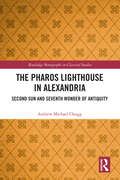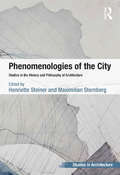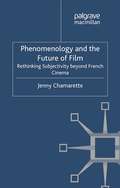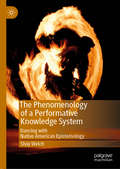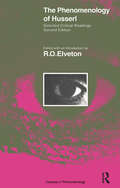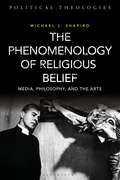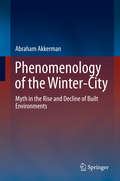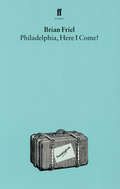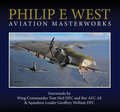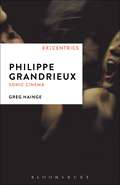- Table View
- List View
The Pharos Lighthouse In Alexandria: Second Sun and Seventh Wonder of Antiquity (Routledge Monographs in Classical Studies)
by Andrew Michael ChuggThis comprehensive and insightful book brings scientific rigor to the problems of reconstructing the Pharos Lighthouse, one of the Seven Wonders of the Ancient World, and understanding how it functioned as the archetypal lighthouse in antiquity, when it was described as a “second Sun”. Conceived by Alexander the Great and designed by Sostratus, the Pharos lighthouse stood as an iconic landmark of Alexandria for sixteen centuries until felled by a calamitous earthquake in the fourteenth century. The study of this great lighthouse has been neglected relative to other ancient Wonders such as the Great Pyramid of Giza. This book reconstructs the tower, its lustrous light, stunning statues and astounding story in diligent detail through archaeological evidence and surviving antique texts and images, providing a fresh evaluation of the Pharos, its history, and its legacy. The Roman writer Achilles Tatius termed the Pharos a “second Sun”; this expression is explained and explored here for the first time, and has dramatic implications for the nature of the Pharos’ light. The volume also explores how the creation of the Pharos was a key stimulus for Alexandrian science and astronomy in antiquity. The Pharos Lighthouse in Alexandria provides a fascinating new study of this monument of interest to students and scholars of Hellenistic art, architecture, and science, and readers seeking to learn more about one of the Seven Wonders of the Ancient World.
The Pharos Lighthouse In Alexandria: Second Sun and Seventh Wonder of Antiquity (Routledge Monographs in Classical Studies)
by Andrew Michael ChuggThis comprehensive and insightful book brings scientific rigor to the problems of reconstructing the Pharos Lighthouse, one of the Seven Wonders of the Ancient World, and understanding how it functioned as the archetypal lighthouse in antiquity, when it was described as a “second Sun”. Conceived by Alexander the Great and designed by Sostratus, the Pharos lighthouse stood as an iconic landmark of Alexandria for sixteen centuries until felled by a calamitous earthquake in the fourteenth century. The study of this great lighthouse has been neglected relative to other ancient Wonders such as the Great Pyramid of Giza. This book reconstructs the tower, its lustrous light, stunning statues and astounding story in diligent detail through archaeological evidence and surviving antique texts and images, providing a fresh evaluation of the Pharos, its history, and its legacy. The Roman writer Achilles Tatius termed the Pharos a “second Sun”; this expression is explained and explored here for the first time, and has dramatic implications for the nature of the Pharos’ light. The volume also explores how the creation of the Pharos was a key stimulus for Alexandrian science and astronomy in antiquity. The Pharos Lighthouse in Alexandria provides a fascinating new study of this monument of interest to students and scholars of Hellenistic art, architecture, and science, and readers seeking to learn more about one of the Seven Wonders of the Ancient World.
Phenomenologies of the City: Studies in the History and Philosophy of Architecture (Ashgate Studies in Architecture)
by Henriette Steiner Maximilian SternbergPhenomenologies of the City: Studies in the History and Philosophy of Architecture brings architecture and urbanism into dialogue with phenomenology. Phenomenology has informed debate about the city from social sciences to cultural studies. Within architecture, however, phenomenological inquiry has been neglecting the question of the city. Addressing this lacuna, this book suggests that the city presents not only the richest, but also the politically most urgent horizon of reference for philosophical reflection on the cultural and ethical dimensions of architecture. The contributors to this volume are architects and scholars of urbanism. Some have backgrounds in literature, history, religious studies, and art history. The book features 16 chapters by younger scholars as well as established thinkers including Peter Carl, David Leatherbarrow, Alberto Pérez-Gomez, Wendy Pullan and Dalibor Vesely. Rather than developing a single theoretical statement, the book addresses architecture’s relationship with the city in a wide range of historical and contemporary contexts. The chapters trace hidden genealogies, and explore the ruptures as much as the persistence of recurrent cultural motifs. Together, these interconnected phenomenologies of the city raise simple but fundamental questions: What is the city for, how is it ordered, and how can it be understood? The book does not advocate a return to a naive sense of ’unity’ or ’order’. Rather, it investigates how architecture can generate meaning and forge as well as contest social and cultural representations.
Phenomenologies of the City: Studies in the History and Philosophy of Architecture (Ashgate Studies in Architecture)
by Henriette Steiner Maximilian SternbergPhenomenologies of the City: Studies in the History and Philosophy of Architecture brings architecture and urbanism into dialogue with phenomenology. Phenomenology has informed debate about the city from social sciences to cultural studies. Within architecture, however, phenomenological inquiry has been neglecting the question of the city. Addressing this lacuna, this book suggests that the city presents not only the richest, but also the politically most urgent horizon of reference for philosophical reflection on the cultural and ethical dimensions of architecture. The contributors to this volume are architects and scholars of urbanism. Some have backgrounds in literature, history, religious studies, and art history. The book features 16 chapters by younger scholars as well as established thinkers including Peter Carl, David Leatherbarrow, Alberto Pérez-Gomez, Wendy Pullan and Dalibor Vesely. Rather than developing a single theoretical statement, the book addresses architecture’s relationship with the city in a wide range of historical and contemporary contexts. The chapters trace hidden genealogies, and explore the ruptures as much as the persistence of recurrent cultural motifs. Together, these interconnected phenomenologies of the city raise simple but fundamental questions: What is the city for, how is it ordered, and how can it be understood? The book does not advocate a return to a naive sense of ’unity’ or ’order’. Rather, it investigates how architecture can generate meaning and forge as well as contest social and cultural representations.
Phenomenology and the Future of Film: Rethinking Subjectivity Beyond French Cinema
by J. ChamaretteUsing hybrid phenomenological approaches to film, this book focuses on how moving images are 'experienced' and 'encountered' as well as 'read' and 'viewed'. Its close engagements with films and installations by four contemporary French filmmakers explore the limits and possibilities of 'cinematic' subjectivity.
The Phenomenology of a Performative Knowledge System: Dancing with Native American Epistemology (Performance Philosophy Ser.)
by Shay WelchThis book investigates the phenomenological ways that dance choreographing and dance performance exemplify both Truth and meaning-making within Native American epistemology, from an analytic philosophical perspective. Given that within Native American communities dance is regarded both as an integral cultural conduit and “a doorway to a powerful wisdom,” Shay Welch argues that dance and dancing can both create and communicate knowledge. She explains that dance—as a form of oral, narrative storytelling—has the power to communicate knowledge of beliefs and histories, and that dance is a form of embodied narrative storytelling. Welch provides analytic clarity on how this happens, what conditions are required for it to succeed, and how dance can satisfy the relational and ethical facets of Native epistemology.
The Phenomenology of Husserl: Selected Critical Readings
by R. O. ElvetonThese essays present appraisals of Edmund Husserl's phenomenological philosophy, ranging from its earliest reception to the first comprehensive efforts to assess the full scope of Husserl's writings.
The Phenomenology of Husserl: Selected Critical Readings
by R. O. ElvetonThese essays present appraisals of Edmund Husserl's phenomenological philosophy, ranging from its earliest reception to the first comprehensive efforts to assess the full scope of Husserl's writings.
The Phenomenology of Real and Virtual Places (Routledge Studies in Contemporary Philosophy)
by Erik ChampionThis collection of essays explores the history, implications, and usefulness of phenomenology for the study of real and virtual places. While the influence of phenomenology on architecture and urban design has been widely acknowledged, its effect on the design of virtual places and environments has yet to be exposed to critical reflection. These essays from philosophers, cultural geographers, designers, architects, and archaeologists advance the connection between phenomenology and the study of place. The book features historical interpretations on this topic, as well as context-specific and place-centric applications that will appeal to a wide range of scholars across disciplinary boundaries. The ultimate aim of this book is to provide more helpful and precise definitions of phenomenology that shed light on its growth as a philosophical framework and on its development in other disciplines concerned with the experience of place.
The Phenomenology of Real and Virtual Places (Routledge Studies in Contemporary Philosophy)
by Erik Malcolm ChampionThis collection of essays explores the history, implications, and usefulness of phenomenology for the study of real and virtual places. While the influence of phenomenology on architecture and urban design has been widely acknowledged, its effect on the design of virtual places and environments has yet to be exposed to critical reflection. These essays from philosophers, cultural geographers, designers, architects, and archaeologists advance the connection between phenomenology and the study of place. The book features historical interpretations on this topic, as well as context-specific and place-centric applications that will appeal to a wide range of scholars across disciplinary boundaries. The ultimate aim of this book is to provide more helpful and precise definitions of phenomenology that shed light on its growth as a philosophical framework and on its development in other disciplines concerned with the experience of place.
The Phenomenology of Religious Belief: Media, Philosophy, and the Arts (Political Theologies)
by Michael J. ShapiroIn The Phenomenology of Religious Belief, the renowned philosopher Michael J. Shapiro investigates how art – and in particular literature and film – can impact upon both traditional interpretations and critical studies of religious beliefs and experiences. In doing so, he examines the work of prolific and award-winning writers such as Toni Morrison, Philip K. Dick and Robert Coover. By placing their work in conjunction with critical analyses of media by the likes of Ingmar Bergman and Pier Paolo Pasolini and combining it with the work of groundbreaking thinkers such as George Canguilhem, Giorgio Agamben and Slavoj Žižek, Shapiro takes a truly interdisciplinary approach to the question of how life should be lived. His assessment of phenomenological subjectivity also leads him to question the nature of political theology and extend the criticism of Pauline theology.
The Phenomenology of Religious Belief: Media, Philosophy, and the Arts (Political Theologies)
by Michael J. ShapiroIn The Phenomenology of Religious Belief, the renowned philosopher Michael J. Shapiro investigates how art – and in particular literature and film – can impact upon both traditional interpretations and critical studies of religious beliefs and experiences. In doing so, he examines the work of prolific and award-winning writers such as Toni Morrison, Philip K. Dick and Robert Coover. By placing their work in conjunction with critical analyses of media by the likes of Ingmar Bergman and Pier Paolo Pasolini and combining it with the work of groundbreaking thinkers such as George Canguilhem, Giorgio Agamben and Slavoj Žižek, Shapiro takes a truly interdisciplinary approach to the question of how life should be lived. His assessment of phenomenological subjectivity also leads him to question the nature of political theology and extend the criticism of Pauline theology.
Phenomenology of the Winter-City: Myth in the Rise and Decline of Built Environments
by Abraham AkkermanThis book explores how the weather and city-form impact the mind, and how city-form and mind interact. It builds on Merleau-Ponty’s contention that mind, the human body and the environment are intertwined in a singular composite, and on Walter Benjamin’s suggestion that mind and city-form, in mutual interaction, through history, have set the course of civilization. Bringing together the fields of philosophy, urbanism, geography, history, and architecture, the book shows the association of existentialism with prevalence of mood disorder in Northern Europe at the close of Little Ice Age. It explains the implications of city-form and traces the role of the myths and allegories of urban design as well as the history of gender projection onto city-form. It shows how urbanization in Northern Europe provided easier access to shelter, yet resulted in sunlight deprivation, and yielded increasing incidence of depression and other mental disorder among the European middle-class. The book uses the examples of Kierkegaard, Nietzsche, Dostoevsky and Kafka, to show how walking through the streets, squares and other urban voids became the informal remedy to mood disorder, a prominent trait among founders of modern Existentialism. It concludes by describing how the connection of anguish and violence is relevant to winter depression in cities, in North America in particular.
The Phenomenon of Architecture in Cultures in Change
by David OakleyThe Phenomenon of Architecture in Cultures in Change focuses on the study of architectural design and its impact in the developing world. The book first elaborates on architectural function and problems and building problems. Discussions focus on a unified form of classification to characterize building context, architecture and society, development process and the building process, understanding of architectural form, and exploring architecture. The text then ponders on economy, intentions, ideas, and method in design. Topics include method in design work, formal articulation and architectural expression, synthesis of critical approaches, architectural ideas, search for system in design work, and economy and the design process. The manuscript examines education and architecture and community, as well as urbanizing rural region, residential urban renewal, and town design service. The book is a dependable source of data for architects and researchers interested in the phenomenon of architecture.
PHIGS by Example
by William A. Gaman William A. GiovinazzoThe Programmer's Hierarchical Interactive Graphics System (PHIGS) is a computer-graphics standard defining an interface between an application program and a computer-graphics system. PHIGS has been actively under development since 1980. Much of this development has been performed by Technical Committee X3H3 under the American National Standard Institute (ANSI) procedures. PHIGS is also an international standard sponsored by the United States and developed by the international computer-graphics committee, ISO TC97/SC21/WG2. In addition, PHIGS has been selected as the graphics extension to the X-window standard and as part of the Intel i860 P.A.X. standard. The PHIGS standard has received wide acceptance throughout the computer graphics industry. PHIGS libraries are available on most of the high performance three-dimensional graphics platforms. These include IBM, DEC, HP, Sun, Alliant, Stardent, and Silicon Graphics. Despite this acceptance, there are few texts that provide the software engineer with an overview of the standard. The only currently available PHIGS references are in the form of the ANSI functional description, technical papers, and device-specific PHIGS to the novice PHIGS programmer.
The Philadelphia Country House: Architecture and Landscape in Colonial America
by Elizabeth McLean Mark E. ReinbergerColonial Americans, if they could afford it, liked to emulate the fashions of London and the style and manners of English country society while at the same time thinking of themselves as distinctly American. The houses they built reflected this ongoing cultural tension. By the mid-eighteenth century, Americans had developed their own version of the bourgeois English countryseat, a class of estate equally distinct in social function and form from townhouses, rural plantations, and farms. The metropolis of Philadelphia was surrounded by a particularly extraordinary collection of country houses and landscapes. Taken together, these estates make up one of the most significant groups of homes in colonial America.In this masterly volume, Mark Reinberger, a senior architectural historian, and Elizabeth McLean, an accomplished scholar of landscape history, examine the country houses that the urban gentry built on the outskirts of Philadelphia in response to both local and international economic forces, social imperatives, and fashion. What do these structures and their gardens say about the taste of the people who conceived and executed them? How did their evolving forms demonstrate the persistence of European templates while embodying the spirit of American adaptation?The Philadelphia Country House explores the myriad ways in which these estates�which were located in the country but responded to the ideas and manners of the city�straddled the cultural divide between urban and rural. Moving from general trends and building principles to architectural interiors and landscape design, Reinberger and McLean take readers on an intimate tour of the fine, fashionable elements found in upstairs parlors and formal gardens. They also reveal the intricate working world of servants, cellars, and kitchen gardens. Highlighting an important aspect of American historic architecture, this handsome volume is illustrated with nearly 150 photographs, more than 60 line drawings, and two color galleries.
Philadelphia, Here I Come: Philadelphia, Here I Come!; The Freedom Of The City; Living Quarters; Aristocrats; Faith Healer; Translations
by Brian FrielFed up with the dreary round of life in Ballybeg, with his uncommunicative father and the humiliating job in his father's grocery shop, with his frustrated love for Kathy Doogan who married a richer, more successful young man and with the total absence of prospect and opportunity in his life at home, Gareth O'Donnell has accepted his aunt's invitation to come to Philadelphia. Now, on the eve of his departure, he is not happy to be leaving Ballybeg.With this play Brian Friel made his reputation and it is now an acknowledged classic of modern drama.
The Philadelphia School and the Future of Architecture (Routledge Research in Architecture)
by John LobellFlourishing from 1951 to 1965, the Philadelphia School was an architectural golden age that saw a unique convergence of city, practice, and education, all in renewal. And it was a bringing together of architecture, city and regional planning, and landscape architecture education under the leadership of Dean G. Holmes Perkins. During that time at the architecture school at the University of Pennsylvania (known as the Graduate School of Fine Arts or GSFA), Louis Kahn and Robert Venturi were transforming modern architecture; Romaldo Giurgola was applying continental philosophy to architectural theory; Robert Le Ricolais was building experimental structures; Ian McHarg was questioning Western civilization and advancing urban and regional ecology; Herbert Gans was moving into Levittown; and Denise Scott Brown was forging a syncretism of European and American planning theory and discovering popular culture. And in the city, Edmund Bacon was directing the most active city planning commission in the country. This book describes the history of the school, the transformation of the city of Philadelphia, and the philosophy of the Philadelphia School in the context of other movements of the time, and looks at what the Philadelphia School has to offer to architecture today and in the future, all from the point of view of a student who was there.
The Philadelphia School and the Future of Architecture (Routledge Research in Architecture)
by John LobellFlourishing from 1951 to 1965, the Philadelphia School was an architectural golden age that saw a unique convergence of city, practice, and education, all in renewal. And it was a bringing together of architecture, city and regional planning, and landscape architecture education under the leadership of Dean G. Holmes Perkins. During that time at the architecture school at the University of Pennsylvania (known as the Graduate School of Fine Arts or GSFA), Louis Kahn and Robert Venturi were transforming modern architecture; Romaldo Giurgola was applying continental philosophy to architectural theory; Robert Le Ricolais was building experimental structures; Ian McHarg was questioning Western civilization and advancing urban and regional ecology; Herbert Gans was moving into Levittown; and Denise Scott Brown was forging a syncretism of European and American planning theory and discovering popular culture. And in the city, Edmund Bacon was directing the most active city planning commission in the country. This book describes the history of the school, the transformation of the city of Philadelphia, and the philosophy of the Philadelphia School in the context of other movements of the time, and looks at what the Philadelphia School has to offer to architecture today and in the future, all from the point of view of a student who was there.
Philanthropy and Light: Carnegie Libraries and the Advent of Transatlantic Standards for Public Space
by Oriel PrizemanWalter Gropius associated standardisation with promoting civilisation in 1935, yet Andrew Carnegie’s influence on the proliferation of pattern book public library plans internationally predated these observations by 50 years. Through the first twenty years of his programme, he supported the erection of almost three thousand public buildings across Britain and America. Though better acknowledged in the US than the UK, this philanthropic contribution radically extended the scope of public provision and remains incomparable in its scale and scope in both nations. Frequently engraved with the self-deifying slogan Let there be Light , open access to navigate these new interior public spaces after work coincided with the first provision of electric light. Towards the end of the nineteenth century, professional groups had sought to specify minimum standards of natural light and air for schools and hospitals. However, the commercial quantification of electricity accelerated the development of a readily comparable vocabulary to prescribe adequate quantities of light for all tasks regardless of their location or orientation. Seeking to gauge the extent of universal values, this book concentrates on the design and performance of a handful of early Carnegie library buildings in Britain and America, identifying their response to contemporary design theory, but also by contrast to their respective local environmental contexts. It examines whether their standards of provision were equitable and if these privately financed public buildings were the first roots of generically standardised public environments to be shared transatlantically. The book also argues that the public library building type can provide a datum for acknowledging the twentieth century legacy of shared international environmental standards for public spaces more broadly.
Philanthropy and Light: Carnegie Libraries and the Advent of Transatlantic Standards for Public Space
by Oriel PrizemanWalter Gropius associated standardisation with promoting civilisation in 1935, yet Andrew Carnegie’s influence on the proliferation of pattern book public library plans internationally predated these observations by 50 years. Through the first twenty years of his programme, he supported the erection of almost three thousand public buildings across Britain and America. Though better acknowledged in the US than the UK, this philanthropic contribution radically extended the scope of public provision and remains incomparable in its scale and scope in both nations. Frequently engraved with the self-deifying slogan Let there be Light , open access to navigate these new interior public spaces after work coincided with the first provision of electric light. Towards the end of the nineteenth century, professional groups had sought to specify minimum standards of natural light and air for schools and hospitals. However, the commercial quantification of electricity accelerated the development of a readily comparable vocabulary to prescribe adequate quantities of light for all tasks regardless of their location or orientation. Seeking to gauge the extent of universal values, this book concentrates on the design and performance of a handful of early Carnegie library buildings in Britain and America, identifying their response to contemporary design theory, but also by contrast to their respective local environmental contexts. It examines whether their standards of provision were equitable and if these privately financed public buildings were the first roots of generically standardised public environments to be shared transatlantically. The book also argues that the public library building type can provide a datum for acknowledging the twentieth century legacy of shared international environmental standards for public spaces more broadly.
Philip E West Aviation Masterworks
by Philip E WestPhilip E West is recognised as one of the world's finest aviation artists. Collectors of his original oil paintings span the globe, many waiting patiently for his next breath-taking canvas to appear. With more than 100 limited editions behind him, a waiting list of commissioned paintings for clients both existing and new, and a head full of ideas for new limited edition prints, life is never dull for the Wiltshire based artist! Self-taught, after years of painting pictures for friends and relatives, Philip took the plunge and became a full-time professional artist. Since when he has developed a very loyal and expanding following for both his original paintings and prints which fetch up to £6000 for the originals. Whilst jets, and Phantoms in particular, light Philip’s fire, he is also a master painter of piston-engined classics and is renowned for his rendition of Avro Lancasters and Supermarine Spitfires. Philip's knowledge of aircraft and the accuracy of his work combine to record a moment in history so perfectly, that both collectors and admirers of his work are able to feel a real sense of the excitement and drama that his work portrays. For the first time, the best of these magnificent paintings have been painstakingly scanned and included in a luxury hardback book, to tie in with the 100th anniversary of the RAF this year. Each full-colour reproduction carries an explanatory caption, while Philip has composed an Introduction explaining how his paintings have become his tapestry to a remarkable career. The book includes Forewords from two famous World War II veterans, written shortly before their deaths in July 2018: Wing Commander Tom Neil DFC and Squadron Leader Geoffrey Wellum DFC.
Philippe Garrel (French Film Directors Series)
by Michael LeonardDescribed by Giles Deleuze as ‘one of the greatest modern auteurs’, Philippe Garrel is widely acknowledged as the most significant filmmaker to emerge in France after the New Wave. His deeply personal cinema traces the troubled sentimental lives of couples, exploring the relationship between art and political struggle. This study observes the eclecticism of the director’s influences, looking to avant-garde movements such as the Situationists, Surrealism, Arte Povera and the American Underground, in order to explore his original body of work. Consideration is also given to Garrel’s relationship with other members of the so-called ‘post-New Wave’, including Jean Eustache and Chantal Akerman. The first book on Garrel’s cinema to appear in English, it will appeal to Garrel enthusiasts as well as to students and lecturers specialising in film studies or French studies.
Philippe Garrel (French Film Directors Series)
by Michael LeonardDescribed by Giles Deleuze as ‘one of the greatest modern auteurs’, Philippe Garrel is widely acknowledged as the most significant filmmaker to emerge in France after the New Wave. His deeply personal cinema traces the troubled sentimental lives of couples, exploring the relationship between art and political struggle. This study observes the eclecticism of the director’s influences, looking to avant-garde movements such as the Situationists, Surrealism, Arte Povera and the American Underground, in order to explore his original body of work. Consideration is also given to Garrel’s relationship with other members of the so-called ‘post-New Wave’, including Jean Eustache and Chantal Akerman. The first book on Garrel’s cinema to appear in English, it will appeal to Garrel enthusiasts as well as to students and lecturers specialising in film studies or French studies.
Philippe Grandrieux: Sonic Cinema (EX:CENTRICS)
by Greg HaingePhilippe Grandrieux is one of cinema's only living true radicals and feted as one of the most innovative and important film makers of his generation. His consistently controversial work remains, however, relatively unknown outside of the international art film festival circuit. In this volume, the first book-length study of the work of Grandrieux in any language, Greg Hainge provides an overview and critical analysis of Grandrieux's entire career during which he has produced works for television, video installations, photography, performance pieces, documentary films, short films and prize-winning feature films. As well as providing an overview, the book argues that a critical appraisal of his work necessarily leads us to problematize many of the critical orthodoxies that have been formed in recent times, to reject the concept of a haptic cinema and to supplant this instead with the idea of a sonic cinema.
